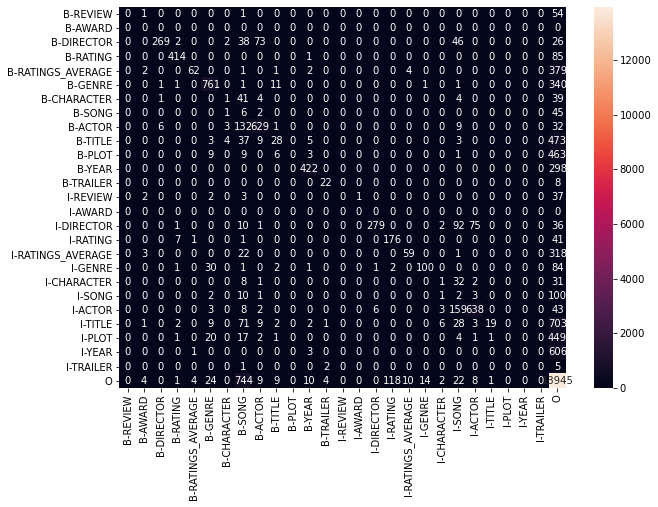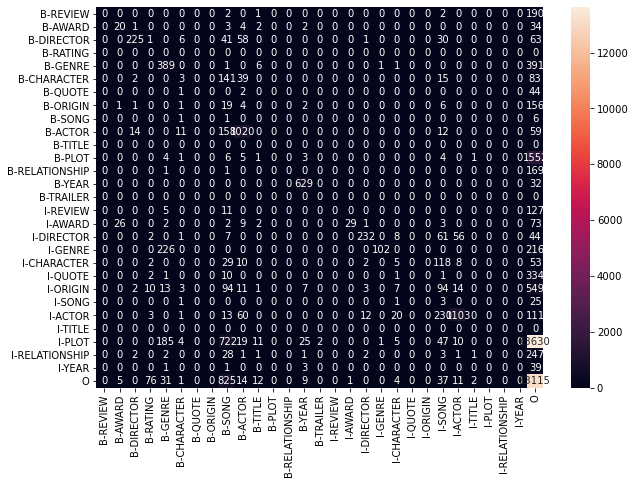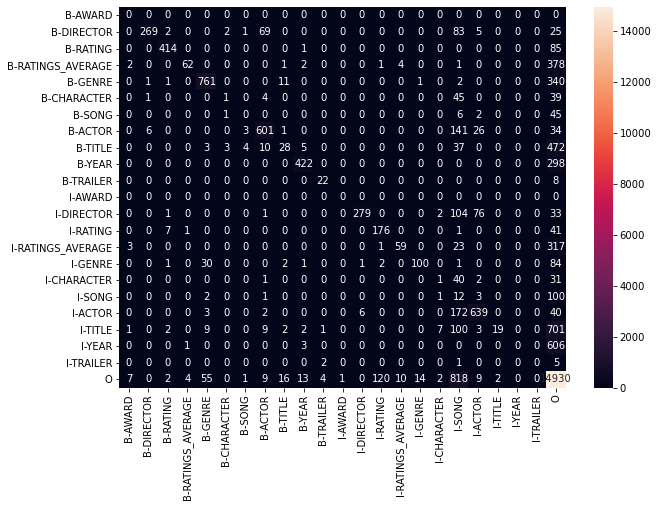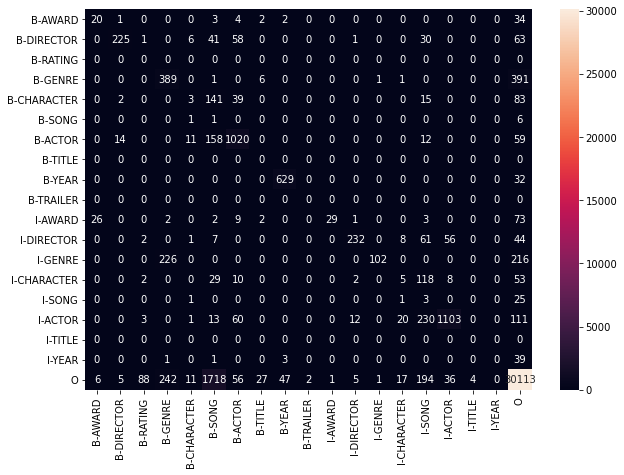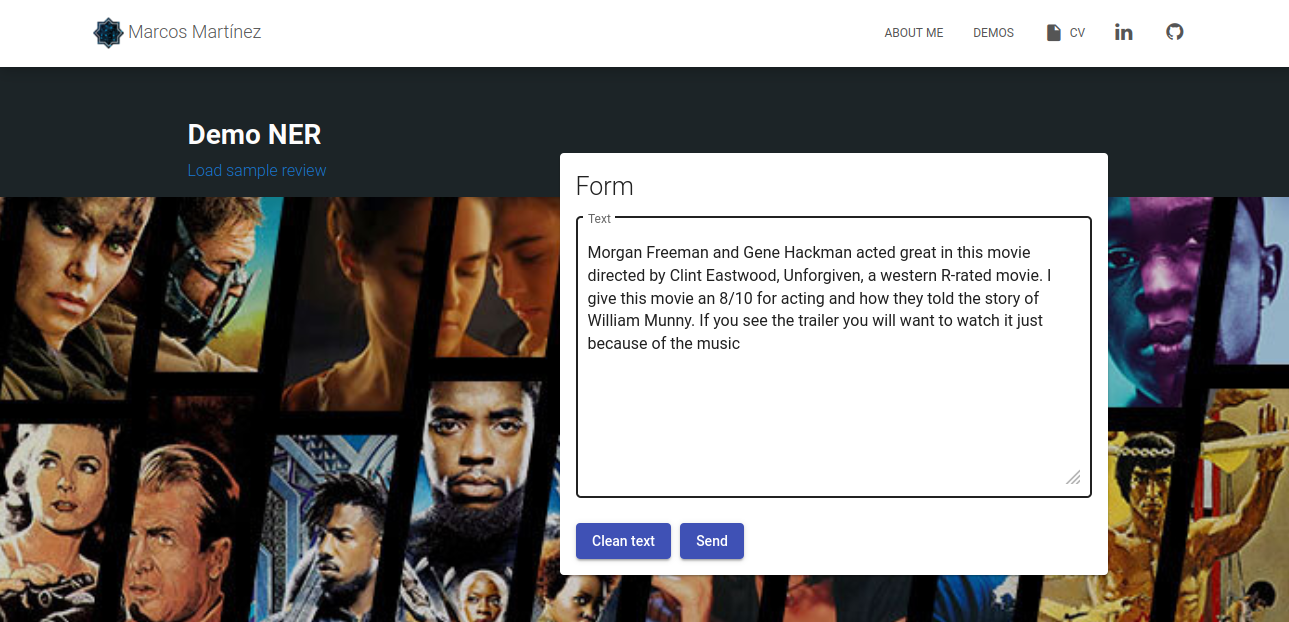Code for the NER test. Prepare data and extract entities from movie reviews and queries.
You can try the demo web app with your own queries and reviews!
Install the requirements file to make it work. Torch installation may fail, see the documentation.
Spacy models have to be installed too, with:
sh python -m spacy download en_core_web_lg
The data is a collection of queries about movies. The problem consists on recgnize different entities in the queries, and in order to do that, two files are provided with queries labelled in the BIO format.
Each file comes with its own set of labels, but as they are similar it has been decided to merge them and create a unique set of labels, which will make easier the process of training and extraction.
The full set of entities to be recongnized are the next ones:
REVIEWAWARDDIRECTORRATINGRATINGS_AVERAGEGENRECHARACTERQUOTEORIGINSONGACTORTITLEPLOTRELATIONSHIPYEARTRAILER
There are some of them that are just some words (e.g. the TRAILER), but other are really complex such as PLOT, QUOTE or REVIEWS. This are some examples of PLOT:
- Sample 1
did O
dame B-ACTOR
judy I-ACTOR
dench I-ACTOR
star O
in O
a O
british B-PLOT
film O
about O
queen B-CHARACTER
elizabeth I-CHARACTER
- Sample 2
show O
me O
a O
movie O
about O
cars B-PLOT
that I-PLOT
talk I-PLOT
As it can be seen it is really difficult to find a patter to recognize this entity. Thus, some labels are not going to be recognized to focus efforts in the other ones that are more interesting, like ACTOR or TITLE. The list of labels to be recognized is the next one:
AWARDDIRECTORRATINGRATINGS_AVERAGEGENRECHARACTERSONGACTORTITLEYEARTRAILER
The data contains also some errors and mismatches. For instance take a look into the next sample, in which harry potter appears labelled as TITLE, but in fact it is the main CHARACTER of a serie of films. Or in the same sample, the word soundtrack that it is mispelled.
can O
you O
get O
a O
soundtrac B-SONG
for O
the O
harry B-TITLE
potter I-TITLE
films I-TITLE
Or in this sample, in which the word directed appears labelled as DIRECTOR when it is not.
who O
directed B-DIRECTOR
the O
film O
pulp B-TITLE
fiction I-TITLE
that O
starred O
john B-ACTOR
travolta I-ACTOR
This is because the main idea behind this dataset is to be able to answer the user queries and to return the data it is asking for. But for a NER problem this causes models to fail, because even when the user is asking for a DIRECTOR, there is no DIRECTOR in the text, and thus it shoudln't be recognized.
The first approach was to train an Albert model and a Spacy model to extract the entities from both files. This didn't work because the queries are really complex, the entities to extract are ambiguous and in some cases are wrong. This results in models that will always fail.
After seeing that to train a NER model to solve the problem wasn't enough, a more traditional process was tested, this is, the use of knowledge resources and regular expressions to find the entities. This is not as powerful as Deep Learning, but when the data is complex and there are not enough samples to train, used to work better than Deep Learning.
In this case there are different technologies working together to extract entities. For instance let's go deeper into the way actors, directors and characters are recognized:

The first thing is to run the Spacy NER pretrained model and the Albert NER model to extract the entities. Then, the person entities are analyzed to check if it corresponds to an actor, to a director or to a character. In order to do this, the entity is searched into the actors and directors list. In case it only appears in one of the lists, that label is assigned. In case it does not appear in any of the lists, the CHARACTER label is assigned. The problem appears when the person is both a director and an actor. To solve this two approaches are used. A question is made to a Question Answering model, asking if the person appears in the text as an actor. If there is any result, it is finally checked with a regular expression to assure that it is not a director. In case the QA model does not answer anything a second question is made, asking if the persons appears as a director in the text. Once again, a regular expression is used to check the result.
This way all the person labels detected are assigned to one of: actor, director or character. But there are sometimes that it is the name of a composer or singer, so if a CHARACTER label appears next to a SONG label it is deleted from the characters list.
If for some reason there is an actor or director in the text that has not been recognized with this method there is still another chance for it. The code tries to match the movie the text speaks about with a database of movies. If it is matched, the title, the genres, the actors and the directors are searched in the text.
Even when it is a powerful and robust method, it has some disadvantages:
- Slow method: In the worst case, it is needed to run a Spacy model, an Albert model for NER and 2 Albert models for QA.
- NER problems: In case the name is not recognized by any of the models it will be not recognized. This may be due to case problems. (This models are trained with names in uppercase, so names in lowercase tends to not be recognized. To solve this some libraries try to correct the case, but they are too slow. Another option is to train the models with names in lowercase.
- Spell errors: If the name has any spell error it is not going to be matched in this approach. To solve this is not too complex, for example a fuzzy search could be done with, for instance, the Levenshtein distance in order to match the names.
There are several improvements that could be done in order to get a better performance.
The main problem found is the quality of the data and the entities to be recognized, which makes very difficult to train a NER model to solve the problem. So, one approach to test would be to clean the data, to obtain more data and to train a model (both Albert or Spacy) to check if it is possible to recognize directly some entities.
This may not work (almost for sure will not), so the next steps will be to improve the approach mentioned before. These are some things that would be interesting to try:
- To re-train the Language Models with movie reviews to adapt the model to the domain.
- The usage of a truecaser to solve the casing problems.
- To train NER models with names in lowercase.
- To use Levenshtein distance or other fuzzy search to match names.
- To improve regular expressions used.
- To augmentate knowledge resources (such as persons lists or movies database).
And of course, next steps will include the recognition of the entities that are not being recognized, like PLOT, ORIGIN, QUOTE or REVIEW. This could be done with regular expresions, because almost all the samples of this entities are based on words. For instance, ORIGIN labels often contains words such as novel or book.
PLOT or REVIEW are more complex. To solve this paraphrasing models could be used to try to match the movie description with some sentence in the text.
The assets folder contains files used to extract entities, such as list of actors or directors.
As Language Models files are too large (for Albert NER and Albert QA), they can't be uploaded to GitHub and have to be downloaded from the HuggingFace repository. Models trained with Conll03 are the NER models, and the ones trained with SQuADv2 are the QA models. Then, place the files inside src/models/conll03 and src/models/squad, renaming the pytorch_model.bin files to checkpoint.pt. The use of different models will result in different performance, but anyone should work well.
You can also download the models used from here.
The data folder contains the data, raw and processed. See the preprocessing notebook to process the original data.
The src folder contains the source code. The file src/detector.py is the one that contains all the extraction code.
The notebooks folder contains Jupyter notebooks to explore the data, extract the entities and get the metrics.
The entities of both files (engtrain.bio and trivia10k13train.bio) have been unified to make the code generic for both files. Take a look into the preprocessing notebook to see the process.
The metrics (weighted) with all labels are the next ones:
- Precission: 0.72
- Recall: 0.72
- F1-Score: 0.68
Confussion Matrix:
- Precission: 0.28
- Recall: 0.43
- F1-Score: 0.31
Confussion Matrix:
On the other hand, the metrics (weighted) with just the labels that are being recognized are the next ones:
- Precission: 0.79
- Recall: 0.76
- F1-Score: 0.74
Confussion Matrix:
- Precission: 0.93
- Recall: 0.87
- F1-Score: 0.89
Confussion Matrix:
